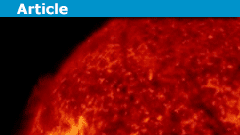Equations of State for Photon Gas and Relativistic Electron Gas
This Insight develops equations of state that are useful in calculations about cosmology and about the insides of stars. The first calculation is for a photon gas and the second is for a ‘relativistic’ gas of particles with mass.
Table of Contents
Photon Gas
Exercise 22 on p108 of Bernard Schutz’s ‘The first course in General Relativity (Second Edition) is to prove that, for anisotropic, monochromatic, photon gas, p=ρ/3, where p is pressure and ρ is mass-energy density.
Say all photons have frequency ##\nu## and the number of photons per cubic metre is ##n##. Then ##\rho=n h \nu##.
Now consider one face of a cube of side length 1m. The pressure on that face is the component, parallel to the normal to the face, of the impulse delivered to that face in one second, by photons striking it from outside the cube. We can ignore components of impulse that are parallel to the face because the isotropy will make such components from different particles cancel each other out.
We measure that impulse by integrating over all photons that at time 0 are in a hemisphere of radius c from the centre of that face, with the base of the hemisphere coplanar with the face. No photons outside the hemisphere can strike that face in the next second.
We use spherical coordinates for the hemisphere and consider a volume element ##dV## from ##r## to ##r+dr##, ##\theta## to ##\theta+d\theta##, ##\phi## to ##\phi+d\phi##
The solid angle subtended by the cube’s face at the centre of ##dV## is ##\frac{cos\theta}{r^2}##. Hence, since the gas is isotropic, the proportion of photons in ##dV## that will strike that face is ##\frac{cos\theta}{4\pi r^2}## and the number of photons in ##dV## at time 0 that will strike the face is ##\frac{n\ dV\ cos\theta}{4\pi r^2}##. The impulse in the direction of the face’s normal that is delivered by those photons will be ##(2\frac{h\nu}{c}cos\theta)\frac{n\ dV\ cos\theta}{4\pi r^2}## . The factor of 2 is there because double the photon’s momentum is transferred when it’s reflected, which is what we assume happens (just as in gas we assume that gas particles bounce off a surface on which pressure is being measured, rather than sticking to it).
Hence the pressure on the face is:
\begin{align*}p = \int 2\frac{h\nu}{c}cos\theta\frac{n cos\theta}{4\pi r^2}dV\\
= \int_0^c\int_0^\frac{\pi}{2}\int_0^{2\pi}2 \frac{ h\nu}{c}cos\theta\frac{n cos\theta}{4\pi r^2}dr\ (r d\theta)\ (r\ sin\theta\ d\phi)\\
= 2\int_0^c\int_0^\frac{\pi}{2}\int_0^{2\pi}\frac{n h\nu}{4\pi c}cos^2\theta\ sin\theta\ dr\ d\theta\ d\phi\\
= 4\pi c \frac{n h\nu}{4\pi c}\int_0^\frac{\pi}{2}cos^2\theta\ sin\theta\ d\theta\\
= n h\nu\Big[-\frac{1}{3}cos^3\theta\Big]_0^\frac{\pi}{2}\\
= \frac{n h\nu}{3}\\
= \frac{\rho}{3}\end{align*}
as required.
Electron Gas
Later in the same textbook, Schutz claims that for a ‘relativistic electron gas’, by which he means a gas of electrons travelling at very high speeds, the formula p = ρ/3 approximately holds (equation 10.79 on p273), and he uses this in deriving formulae for dense stars.
So now we try to prove that the relationship holds approximately for a gas of molecules, each of mass m and velocity v, rather than photons.
Say all electrons have velocity ##v## and the number of electrons per cubic metre is ##n##. Then ##\rho=\frac{n m}{\sqrt{1-v^2}}## (Schutz p42, formula for ##p^0##). This, and all equations below, is written in Schutz’s ‘special relativistic coordinates’ in which time is measured in metres (one unit of time is the time required for light to travel one metre), so that ##c=1## and ##v## represents what would be ##\frac{v}{c}## in conventional metric units.
Now consider one face of a cube of side length 1m. The pressure on that face is the component, parallel to the normal to the face, of the impulse delivered to that face in one second, by electrons striking it from outside the cube. We can ignore components of impulse parallel to the face because the isotropy will make such components from different particles cancel each other out.
We measure that impulse by integrating over all electrons that at time 0 are in a hemisphere of radius ##v## from the centre of that face, with the base of the hemisphere coplanar with the face. No electrons outside the hemisphere can strike that face in the next second.
We use spherical coordinates for the hemisphere and consider a volume element ##dV## from ##r## to ##r+dr##, ##\theta## to ##\theta+d\theta##, ##\phi## to ##\phi+d\phi##
The solid angle subtended by the cube’s face at the centre of ##dV## is ##\frac{cos\theta}{r^2}##. Hence, since the gas is isotropic, the proportion of electrons in ##dV## that will strike that face is ##\frac{cos\theta}{4\pi r^2}## and the number of electrons in ##dV## at time 0 that will strike the face is ##\frac{n\ dV\ cos\theta}{4\pi r^2}##. The impulse in the direction of the face’s normal that is delivered by those electrons will be ##(2\frac{m v}{\sqrt{1-v^2}}cos\theta)\frac{n\ dV\ cos\theta}{4\pi r^2}## . The factor of 2 is there because double the electron’s momentum is transferred when it’s reflected, which is what we assume happens (ie in a gas we assume that gas particles bounce off a surface on which pressure is being measured, rather than sticking to it). The formula for the particle’s momentum ##\frac{m v}{\sqrt{1-v^2}}## comes from Schutz p42, the formula for ##p^1##.
Hence the pressure on the face is:
\begin{align*}p = \int 2\frac{m v}{\sqrt{1-v^2}}cos\theta\frac{n cos\theta}{4\pi r^2}dV\\
= \int_0^v\int_0^\frac{\pi}{2}\int_0^{2\pi}2 \frac{m v}{\sqrt{1-v^2}}cos\theta\frac{n cos\theta}{4\pi r^2}dr\ (r d\theta)\ (r\ sin\theta\ d\phi)\\
= 2\int_0^v\int_0^\frac{\pi}{2}\int_0^{2\pi}\frac{n m v}{4\pi\sqrt{1-v^2}}cos^2\theta\ sin\theta\ dr\ d\theta\ d\phi\\
= 4\pi \frac{n m v^2}{4\pi\sqrt{1-v^2}}\int_0^c cos^2\theta\ sin\theta\ d\theta\\
= \frac{n m v^2}{\sqrt{1-v^2}}\Big[-\frac{1}{3}cos^3\theta\Big]_0^\frac{\pi}{2}\\
= \frac{n m v^2}{3\sqrt{1-v^2}}\\
= \frac{v^2}{3}\rho\end{align*}
We have a superfluous factor of ##v^2##. But if ##v## is high enough, the equation p=ρ/3 is approximately true.
##v## has to be very high though. To get the error below 10% we have to have ##v > 0.95 c##.
Is this really the approximation to which Schutz refers, or is it possible to demonstrate that convergence is faster than that (ie that electron speeds don’t have to e so very high to be approximately true)? Schutz doesn’t tell us. I presume the answer is yes. If so then the gas must be very relativistic indeed for this approximation to be reasonably accurate.
Read my next article Acoustic ‘beats’ from Mismatched Musical Frequencies
- Degree in
- Bachelor: Science and Maths; PostGrad: Actuarial
- Favorite Area of Science
- Mathematics; Physics; Genetics










Leave a Reply
Want to join the discussion?Feel free to contribute!